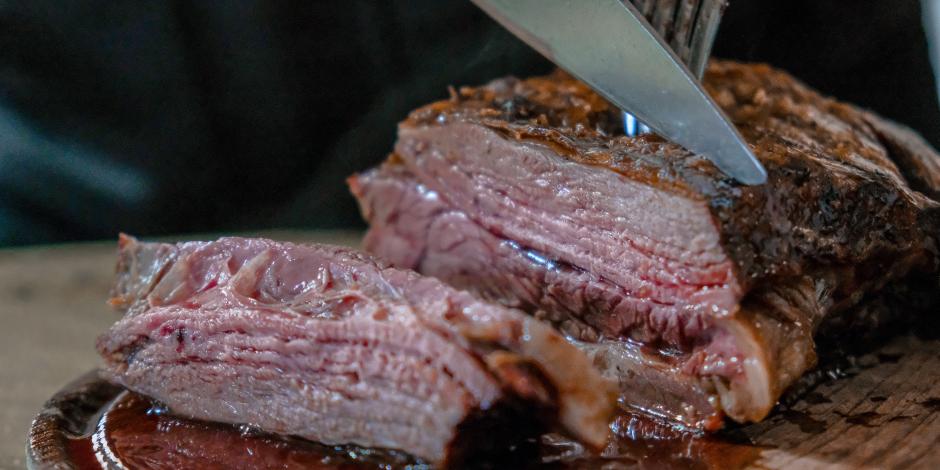Starten Sie den Audio-Text
Mit dem Audio-Player können Sie sich den Text anhören. Darunter finden Sie das Transkript.
When you think of Argentina, what do you think of? Lionel Messi? Barbecues? Steak? In the following article, Business Spotlight correspondent Amy Booth reflects on why Argentines are eating less beef than they used to in the past.
No weekend in Buenos Aires would be complete without the rich smell of grilled meat in the afternoon air. Asado, Argentines’ famous barbecues, are popular all over the country. They are cooked in anything from a fancyraffiniertfancy purpose-builtspeziell angefertigtpurpose-built structure with an adjustableverstellbaradjustable grill to a rackGestellrack over half an oil barrelFassbarrel on a street corner.
Argentina has often had the world’s highest per capitapro Kopfper-capita beefRindfleischbeef consumption. From the country’s iconic gauchos, the horseback cowboys and their enormous herdHerdeherds on the pampas, to premium leather handbags, Argentinian culture is closely linked to cattleVieh, Rindercattle farming.
However, according to the Rosario Board of Trade, beef consumption in Argentina has been falling — in 2021, it reached 47.8 kilograms per person for that year, the lowest figure since 1920. Less beef is being produced, too. Data from the U.S. departmenthier: MinisteriumDepartment of Agriculture shows that Argentina produced 3.02 million tonnes of beef and vealKalbfleischveal in 2022 — a drop of more than five per cent compared to 2020.
Meat-free dietErnährung(sweise)diets are growing in popularity around the world, also in Argentina. The Buenos Aires Province College of nutritionistErnährungswissenschaftler( in)Nutritionists estimated that 12 per cent of the country’s adult population was vegan or vegetarian in 2020, up three percentage points from 2019. Since 2017, the presidential palace, Casa Rosada, has offered meat-free Mondays in the canteen, and in August 2022, the government announced improved labellingKennzeichnunglabelling rules for vegetarian and vegan foods.
A question of economics
However, interest in vegetarianism is not the main reason why Argentines are eating less beef. Actually, surveyUmfragesurveys suggest that many are turning to other sources of animal protein, such as chicken and fish. The real reason is a much more worrying trend: an increasing number of Argentines are poor and to cut back on sth.etw. kürzen; hier: den Konsum von etw. reduzierencutting back on meat because they can’t afford it any more. In the second half of 2020, during one of the world’s longest Covid lockdowns, the poverty rate passed 42 per cent, up from 25.7 per cent just three years earlier. These numbers reflect a deep recession that began well before the pandemic.
Since the worst of the year 2020, the economy has to recoversich erholenrecovered somewhat, but its continued recovery depends on sticking to a 30-month plan to repay a record $44 billlionMilliarde(n)billion in loanDarlehenloans from the International Monetary Fund (IMF). This involves some deeply unpopular measures, such as the removal of subsidySubventionsubsidies for basic goods and a freezeEinfrieren; hier: vorläufiger Stoppfreeze on public-sector hiring.
In an effort to bring down the price of beef, the government has to ban sth.etw. verbietenbanned the export of certain meat cut(s)zerlegtes Fleischmeat cuts until 2024. With annualjährlichannual inflation over 100 per cent early in 2023, that makes little difference. However, despite these challenges, the aroma of asado continues to fill the streets of Buenos Aires — and it seems unlikely that this scentGeruchscent will disappear any time soon.
World watch: Argentina
von Melita Cameron-Wood
History
Once part of South America’s United Provinces of the Río de la Plata, which gained independence from Spain in 1816, Argentina was formed after Paraguay, Bolivia and Uruguay had broken away as separate countries. Throughout its history, Argentina has experienced political unrestUnruhenunrest and a struggle between civilian and military leadership, most famously in the 1940s and 1950s under the military leader and politician Juan Perón. In 1976, a military junta took over the government. Democracy did not return until 1983, following a failed attempt to take the Falkland Islands, which Argentina to claim sth.etw. beanspruchenclaims and calls the Malvinas, by force.
Geography
The world’s eighth-largest country in terms of total area, Argentina has a largely mild climate, which becomes subantarctic in the far south-west. The country has a wealth of natural resourcesBodenschätzenatural resources, including iron oreEisenerziron ore, uranium and a vastriesigvast amount of pasture landWeidelandpasture land, which makes up nearly 40 per cent of the total land area.
Society
Immigration from all over Europe, particularly from Spain and Italy, has had a big impactAuswirkung(en)impact on the country’s culture and demographics. Over 97 per cent of the population is either of European or a mixture of European and indigenousindigenindigenous descentAbstammungdescent. Another 2.4 per cent is indigenous, and 0.4 per cent is of African ethnicity. as ofStand...As of 2023, the population of Argentina was over 46 million.
Languages
Spanish is Argentina’s official language, but Italian, English, German and French, along with the indigenous languages Quechua, Guaraní and Mapudungun, are also widely spoken.
Economy
Argentina’s export-led economy has struggled recently with high inflation and the financial risks caused by its debt obligationSchuldverpflichtung; auch: Staatsverschuldungdebt obligations. Also, the country has a tendency to to under-report sth.etw. zu gering angebenunder-report inflation and to nationalize sth.etw. verstaatlichennationalize businesses, all of which is unsettlingbeunruhigendunsettling for investors.
Services are the largest sector, but other important industries include food processingNahrungsmittelverarbeitungfood processing, motor vehicleKraftfahrzeugmotor vehicles and petrochemicals. Agricultural exports including corn (US)Maiscorn, wheat, sugar caneZuckerrohrsugar cane and beefRindfleischbeef are also important. Argentina’s biggest export markets are Brazil, China, the US and Chile.
Government
Argentina is a presidential republic. Its capital is Buenos Aires. President and head of state has been Alberto Ángel Fernández since December 2019.
Argentina’s National Congress is made up of the Senate and the chamber of deputiesAbgeordnetenkammerChamber of Deputies. Members are elected on a provincial basis, with two Senate seats given to the winning party and one seat to the party with the second-highest number of votes. There are 257 seats in the Chamber of Deputies, whose members servehier: gewählt werdenserve for four-year termhier: Amtszeitterms, while half of the membership must be renewed every two years.
Source: The World Factbook, Central Intelligence Agency
Neugierig auf mehr?
Dann nutzen Sie die Möglichkeit und stellen Sie sich Ihr optimales Abo ganz nach Ihren Wünschen zusammen.



